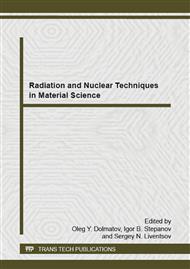[1]
M.G. Matysh, T.L. Kravchuk, V.V. Vysotskaya, V.I. Chernov, V.E. Goldberg, Anthracycline-induced cardiotoxicity: mechanisms of development and clinical manifestations, Siberian J. of Oncology 6 (2008) 66-75 (Russian).
Google Scholar
[2]
L.F. de Geus-Oei, A.M. Mavinkurve-Groothuis, L. Bellersen , M. Gotthardt, W.J. Oyen, L. Kapusta, H.W. van Laarhoven, Scintigraphic techniques for early detection of cancer treatment-induced cardiotoxicity, J. Nucl. Med. 52 (2011) 560-71.
DOI: 10.2967/jnumed.110.082784
Google Scholar
[3]
S. Aggarwal, M. D. Pettersen, K. Bhambhani, J. Gurczynski , R. Thomas, T. L'Ecuyer, B-type natriuretic peptide as a marker for cardiac dysfunction in anthracycline-treated children, J. Pediatr. Blood Cancer 49 (2007) 812-816.
DOI: 10.1002/pbc.21100
Google Scholar
[4]
V.I. Chernov, A.A. Garganeeva, J.V. Vesnina, Y.B. Lishmanov, Myocardial perfusion scintigraphy in the evaluation of the trimetazidine treatment results in patients with ischemic heart disease, J. Cardiology 41 (8) (2001) 14-16 (Russian).
Google Scholar
[5]
P.H. Hardenbergh, M.T. Munley, G.C. Bentel, R. Kedem, S. Borges-Neto, D. Hollis, L.R. Prosnitz , L.B. Marks, Cardiac perfusion changes in patients treated for breast cancer with radiation therapy and doxorubicin: preliminary results, Int. J. Radiat. Oncol. Biol. Phys. 49 (2001).
DOI: 10.1016/s0360-3016(00)01531-5
Google Scholar
[6]
T. Nousiainen, E. Vanninen, E. Jantunen, J. Puustinen, J. Remes, A. Rantala, J. Hartikainen, Comparison of echocardiography and radionuclide ventriculography in the follow-up of left ventricular systolic function in adult lymphoma patients during doxorubicin therapy, J. Int. Med. 249 (2001).
DOI: 10.1046/j.1365-2796.2001.00820.x
Google Scholar
[7]
R.G. Schwartz, W.B. McKenzie, J. Alexander, P. Sager, A. D'Souza, A. Manatunga, P.E. Schwartz, H.J. Berger, J. Setaro, L. Surkin, Congestive heart failure and left ventricular dysfunction complicating doxorubicin therapy: seven-year experience using serial radionuclide angiocardiography, Am. J. Med. 82 (1987).
DOI: 10.1016/0002-9343(87)90212-9
Google Scholar
[8]
A. Lacko, I. Wlodarska, R. Zymlinski, Cardiac toxicity in cancer therapy, Pol. Merkur. Lekarski. 13 (73) (2002) 79-85.
Google Scholar
[9]
M.J. Adams, S.E. Lipshultz, Pathophysiology of anthracycline- and radiation-associated cardiomyopathies: implications for screening and prevention, Pediatr. Blood Cancer 44 (2005) 600-606.
DOI: 10.1002/pbc.20352
Google Scholar
[10]
G.J. Berry, M. Jorden, Pathology of radiation and anthracycline cardiotoxicity, Pediatr. Blood Cancer 44 (2005) 630-637.
DOI: 10.1002/pbc.20346
Google Scholar
[11]
I.W. Gayed, H.H. Liu, S.W. Yusuf, R. Komaki, X. Wei, X. Wang, J.Y. Chang , J. Swafford, L. Broemeling, Z. Liao, The prevalence of myocardial ischemia after concurrent chemoradiation therapy as detected by gated myocardial perfusion imaging in patients with esophageal cancer, J. Nucl. Med. 47 (2006).
DOI: 10.1016/j.nuclcard.2006.06.054
Google Scholar


